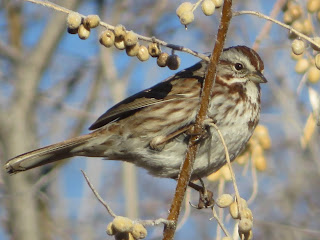New Mexico has always had many contrasts. Dry deserts and flash floods. Cold mornings and hot afternoons. Dusty desert arroyos and muddy river banks
Sunrises are most impressive before a snowstorm, or right after high winds. This sunrise was impressive even for New Mexico; the land of awesome sunsets.
In contrast to the fiery sunrise,this was a picture of the the cool, white/yellow light from the setting moon. Unlike the predictable sunrise, the moon seems to be in the sky at much more unpredictable times, coming and going as it pleases.
The weather is continuing to alternate between hot and cold. The last snow storm disappeared pretty quickly. The next one is already predicted next week.
Often, seeing a common bird in an unusual location can be interesting. This is a common scrub jay, just not seen in the bosque much. Notice that thick, powerful beak. This picture does not show the blue back very well.
This great blue heron also has an imposing beak. Something is attracting the fishing birds to Andrews lane right now. Probably trout, but it could easily be a dozen of other common fish species.
The level of the Rio grande river seems to be rising slowly, and the interior drain, which also reflects the underlying groundwater level, also appears to be increasing incrementally. In the bosque, there are some monitoring stations. This picture shows a site that appears to be abandoned at the moment. The capped white pipes sticking out of the ground are typically drilled down by hand to about 15-20 feet to measure the water table.
Mistletoe is "planted" in the tallest tree by birds while they are roosting. They take several years to actually form plants with berries and flowers. They form links in an ecosystem and are a sign of high biodiversity. They also attract birds and mammals that recycle nutrients.
Because they are hemi-parasites (sort-of-parasites) they help redistribute resources like minerals back to the forest floor. They are succulents and the leaves are full of proteins and sugars. This group of leaves ended up on the forest floor because of a mammal browsing on the stem. mixed in with themistletoe and cottonwood leaves was the tell tale wood pellet scat of porcupines. These animals often clear mistletoe from dense forests as they browse individual trees for mistletoe, buds and bark. They usually feed in that order of preference.
mixed in with themistletoe and cottonwood leaves was the tell tale wood pellet scat of porcupines. These animals often clear mistletoe from dense forests as they browse individual trees for mistletoe, buds and bark. They usually feed in that order of preference. It's a little hard to see in this photo , but this is a haul-out site for beaver, which is where they slide into and out of the pool created by their dams. The pile of debarked and pointed sticks in the water is a clear giveaway of what is otherwise a pretty secretive species. They often store sticks underwater and also use them for building materials after the sticks have been gnawed on like a bone.
It's a little hard to see in this photo , but this is a haul-out site for beaver, which is where they slide into and out of the pool created by their dams. The pile of debarked and pointed sticks in the water is a clear giveaway of what is otherwise a pretty secretive species. They often store sticks underwater and also use them for building materials after the sticks have been gnawed on like a bone.the long fingers on this track mark shows that the raccoons has begun their long nightly walks to look for mates and territories. If they find a food source on the way, so much the better. The pickings for them must be kind of slim right now.
much of the activity on the bosque revolves around food. During the cold winter, the majority of the food is vegetable. Birds rely on drupes, like these Russian Olive seeds that are deposited in helpful sites in bird scat to sprout in new locations.Song sparrows often eat these fruits, they also have been seen dropping many of the Russian Olive fruits into the ditches below where the ducks scoop the fruits out of the water.
Flickers will eat these fruits during breaks from mating. Even though they specialize more as insectivores and seem to choose ants, they will eat seeds and fruit. They do not frequent bird feeders much, however.
 the robin feeds on many seeds and fruits. They feast on New Mexico Olive, Russian Olive, and mistletoe berries, as well as just about anything else that is around.
the robin feeds on many seeds and fruits. They feast on New Mexico Olive, Russian Olive, and mistletoe berries, as well as just about anything else that is around. Wilson's Snipe are very shy and secretive and are not often seen in a group. It takes a while to see them. Because of their camouflage and the fact that they freeze very effectively.
Wilson's Snipe are very shy and secretive and are not often seen in a group. It takes a while to see them. Because of their camouflage and the fact that they freeze very effectively. This picture shows that everyone can find a way to make a buck. It is a sobering reflection that the bosque is in very severe fire danger with fire starters literally lying on the trail, even as people ignore no smoking signs in the public preserve.
This picture shows that everyone can find a way to make a buck. It is a sobering reflection that the bosque is in very severe fire danger with fire starters literally lying on the trail, even as people ignore no smoking signs in the public preserve.













No comments:
Post a Comment